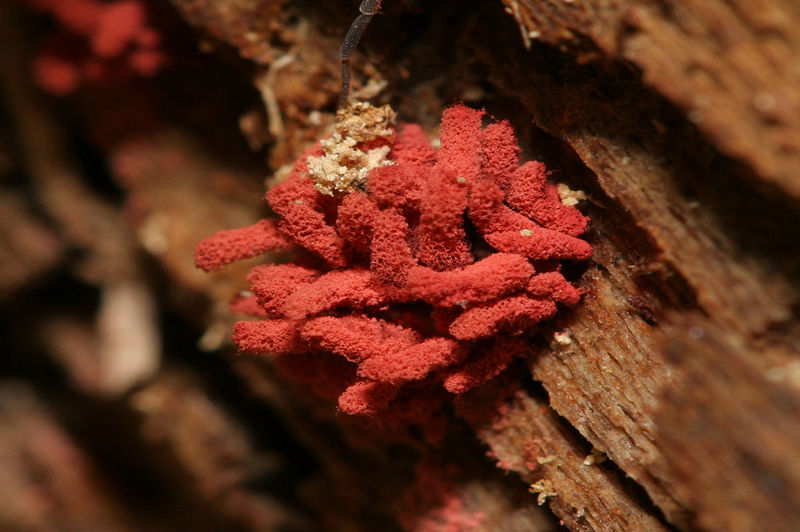Did you know that there are different types of mold, and each type has its various distinctions? Most importantly, what does red mold look like?
If you don’t have any idea, don’t worry because you will learn what you need to know in this article.

What Is Red Mold?
Red mold is a water-borne bacterium most commonly found in bathrooms. Mold can take on a reddish hue due to a variety of factors.
Mold can change color as a result of changes in humidity or exposure to light. Additionally, the food source can influence the color of mold.
Here is a helpful guide on how fast mold grows to help you understand how you can prevent it.
You can find mold almost anywhere. Mold spores must come into contact with a moist surface to grow, and they can begin to grow within 24 to 48 hours in this case.
The most common way to identify molds is to closely examine the structure, spores, and growth morphology, which is challenging to perform without access to a lab. Because one patch might have numerous colors or change color for various causes, color isn’t a solid distinguishing characteristic of mold or toxicity.
Red Mold Appearance
The specific origin of red mold — or any mold for that matter — is very dependent on the growth’s location. Mold thrives in moist, wet environments, so a water leak can cause it to grow around plumbing, in walls, and underneath the carpet.
Red mold is typically not a consistent color, changing colors over time. Because Aspergillus is so common, it’s most likely Aspergillus.
Red mold on food, on the other hand, is most likely caused by Neurospora. Here is a guide article about what causes mold outside the house that we think can be useful to your advantage.
It’s possible that consuming red mold by accident isn’t harmful, but it’s better to be cautious than sorry. Immediately visit a doctor if you’ve been exposed to red mold and are experiencing symptoms of discomfort, especially if you, your relatives, or children in your household are allergic or sensitive to molds.
How To Prevent Red Mold
In preparation and protection, be protected by wearing goggles, gloves, and a dust mask at all times. Before cleaning, open a window to allow for more ventilation.
A bathroom fan can improve airflow while also reducing mold growth. Mold-resistant shower curtains, floor rugs, and tiles are all available for purchase for your bathroom.
Red mold is usually innocuous, but if you’re sensitive, allergic, or have a weakened immune system, it can create health concerns. That’s why it is vital for you to protect yourself when you’re handling these things.
To protect yourself, remove mold from your house as soon as possible, and keep food correctly to avoid accidentally consuming it. You can use an industrial cleaning agent like bleach to remove red mold from hard surfaces like bathroom showers, walls, and floors.
Step #1. Combine one-part bleach and three parts water in a mixing bowl. After that, wet a towel in the bleach solution and wipe the surface clean.
Allow an hour for the answer to rest before scrubbing and rinsing with warm water.
Step #2. You must remove excess moisture to prevent the growth of red mold. Reduce the humidity in your home to do this.
It would help if you keep the indoor humidity levels below 50% as a general rule.
To reduce humidity, turn on your air conditioner or buy a dehumidifier to remove extra moisture from the air. If your shower curtain becomes infected with red mold, place it in the bathtub.
Step #3. Add two quarts of water and 4 tbsp of non-chlorine bleach. Allow an hour for the shower curtain to dry before scrubbing and rinsing with warm water.
Step #4. In a spray bottle, combine two parts hydrogen peroxide and one-part water. Place the shower curtain on the floor flat.
Step #5. Allow the peroxide solution to remain for 30 minutes after spraying it on the curtain. Scrub the surface with a soft brush and then rinse with warm water.
These simple steps will be of great help in removing red molds in your household. However, it is essential to know the extent of damage the red mold has done and suffice with prevalent actions to see if you can still fix the furniture or not.
Conclusion
We hope we have provided a helpful article on what does red mold look like. You can always revisit these vital pieces of information that could help you know more about red molds and different types of red mold.
Another important note for you is to take safety precautions attentively and wisely. If things are far a bit too worse for you to handle, do not hesitate to call for professional help.
Serve yourself with the information above for a broader knowledge of molds and red molds.
